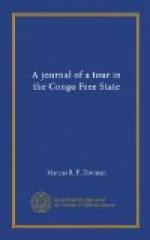At Imese two soldiers and their future brides came on board for the purpose of travelling to Libenge to be married, for only Commissaires of Districts and Missionaries can legally join two into one. The send off was quite pretty, the happy couples being pelted with flowers as they stepped on board, while one friend—perhaps a kind of best man—threw his cap into the river. The State encourages regular marriages, especially among the soldiers. The wife then works in the gardens or plantations, while her husband drills, and returns at midday and in the evening to cook his food.
Next day we reach Dongo, a village situated on a hill perhaps 200 feet high. After looking at flat forest for weeks, this appears a veritable mountain and it seems quite a stiff climb up the rough path constructed as usual only by the feet of the people who have used it. Mr. Vannini, an Italian officer, is constructing a Post here with the aid of some ten or fifteen soldiers. Dongo is a very large village containing perhaps 3000 people and the huts are arranged in streets running parallel to each other with their ends towards the river. The physique of the people is very good indeed, some of the men being more than six feet in height. The women mostly wear copper collars, three inches high and with a second horizontal collar attached on the outside. The whole is hammered on and must be intensely uncomfortable. A special pillow, consisting of a piece of wood hollowed out for the head is necessary, as sleep would otherwise be impossible with such a contrivance round the neck. A great number of children run about and seem to be well nourished. Some have large heads and protruding stomachs, without however, other signs of rickets. Many of the men are painted with yellow stripes, an indication that they have killed their man in battle, and these donned their fighting clothes of many colours and with shields and spears posed to be photographed, dancing around and uttering wild war whoops. A human skull partly buried in the middle of a road is evidently a souvenir of the terrible orgy which followed some recent encounter. Indeed all the people here are cannibals and those killed or captured in war, except women and children, are always eaten. When not fighting, the people fish, collect rubber, grow kwanga and generally work fairly well and are not troublesome. Mr. Vannini, however, evidently thinks it safer to erect a high stockade around his house and the huts of the soldiers. This is a wise precaution, as only a few months ago four French traders were killed and eaten on the opposite bank of the river.




